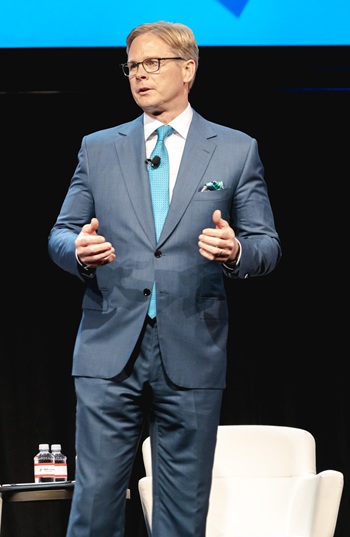
Action is needed now to preserve the U.S.’ energy security and dominance, and an ‘all of the above’ strategy is critical, Quantum Capital Group CEO Wil VanLoh said during a keynote speech at the 2025 NAPE Summit on Feb. 5 in Houston.
The energy industry is transitioning—but the shift is more about the global economy, supply and demand and recognizing that natural resources and capital are finite, said Wil VanLoh, founder and CEO of Quantum Capital Group.
Action is needed now to preserve the U.S.’ energy security and dominance, and an ‘all of the above’ strategy is critical, VanLoh said during a keynote speech at the 2025 NAPE Summit on Feb. 5 in Houston.
“As an industry we need to understand, and hopefully as a country we can come together on this, we need to adopt an ‘all the above’ strategy. If we really want to maintain energy dominance and energy security, we generally need a Manhattan Project’s intensity and focus like we had when we developed the atomic bomb in World War II,” he said.
To achieve the dual goals of maintaining energy dominance and energy security in the U.S., four steps—or rather, giant leaps—need to happen.
From the outset, investment in oil and gas must meaningfully increase to boost resource production and infrastructure building.
“It's abundant, it's affordable, it's reliable, it's here in America and we've got to invest as a country,” he said. However, he added, “We've got to have policy that supports this. We've got to have capital markets to support this.”
Next, the U.S. needs to upgrade and expand the grid—which means supporting all forms of power, including gas, wind and solar.

“Look, our grid is ancient. It is falling apart. It's pathetic,” VanLoh said. “It's vulnerable to cyberattack and it just doesn't work. It's not going to be able to carry the electrons [required] as we continue to move to more electricity and less forms of other power. We've got to build new grids to get the power from where it's developed [to] where it's used in the natural gas space.”
The third step is to shore up the nation’s supply chain to produce the critical minerals needed for electric vehicles and the energy transition.
China has a massive head start, he said.
“I don't actually know if we can ever catch [up with China], but we [should] at least be able supply it for ourselves. They will be the OPEC for the next 50 years on that,” he said. “We need to make sure we have our own abilities here.”
The fourth step? The U.S. needs to go nuclear.
“We need to accelerate the role that nuclear plays in the mix. It's a shame that nuclear, when Three Mile Island happened, just took such a hit from the American public opinion,” he said. “It's really the answer. I mean, candidly, nuclear, it's the only form of clean energy that's 24/7, 365 days a year.
“There's no other energy [like] that today.”
The government needs to fast-track reactor designs and cut regulatory red tape to move the projects forward and make the projects less expensive, he said. The cost of building similar facilities in South Korea or China is a third of that in the U.S.—a factor policy can change, VanLoh said. But it could still take years to bring the projects online.
A combination of these steps for an ‘all of the above’ strategy will take time, commitment and investment, he said.
“But on all of these things, we’ve got to start today,” he said.
Recommended Reading
Howard Energy Partners Closes on Deal to Buy Midship Interests
2025-02-13 - The Midship Pipeline takes natural gas from the SCOOP/STACK plays to the Gulf Coast to feed demand in the Southeast.
Elliott Demands Phillips 66 Sell or Spin Off Midstream Biz for $40B+
2025-02-12 - Activist investor Elliott Capital Management disclosed Feb. 11 it has built a $2.5 billion position in Phillips 66 and issued a series of initiatives, including the sale or spinning off of the company’s midstream assets.
Voyager Midstream Closes on Panola Pipeline Interest Deal
2025-03-19 - Pearl Energy Investments portfolio company Voyager Midstream Holdings has closed on its deal with Phillips 66 for its non-op interest in the Panola Pipeline.
Summit Acquires Moonrise Midstream Assets to Alleviate D-J Constraints
2025-03-10 - A Summit Midstream Corp. (SMC) subsidiary will acquire Moonrise Midstream from Fundare Resources Co. in a cash-and-stock deal valued at $90 million.
Boaz Energy Completes Sale of PermRock Properties to T2S
2025-04-01 - Boaz Energy II has completed the sale of PermRock Royalty Trust’s underlying oil and gas properties to T2S Permian Acquisition II LLC.
Comments
Add new comment
This conversation is moderated according to Hart Energy community rules. Please read the rules before joining the discussion. If you’re experiencing any technical problems, please contact our customer care team.





